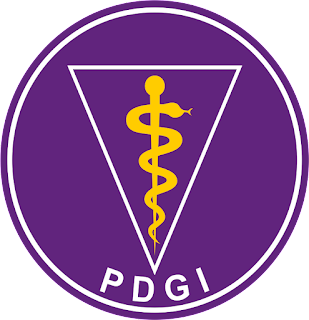ROLE OF COMBINATION CASEIN AND LACTOFERRIN BOVINE’S COLLOSTRUM AS A PULP CAPPING ON MACROPHAGE EXPRESSION IN MALE WISTAR RATS
Abstract
ABSTRACT
Background: Inflammatory and/or non-inflammatory processes play a role in stimulating pulp repair and the formation of hard tissue, namely reparative dentin. Macrophages play a role in the pathogenesis and chronic inflammatory disorders. The combination casein lactoferrin of bovine colostrum as an immunomodulator has therapeutic potential. This study aims to determine the therapeutic effect and duration of application of the combination of casein lactoferrin of bovine colostrum, on the expression of macrophages as pulp capping.
Method: This study was a true experimental laboratories post test only control group design, consisting of three groups of 60 male wistar rats with 4 observation times, namely day to day 7, 14, 21 and 28 each of 5 mice. The maxillary 1st molars were prepared until the roof of the pulp was exposed. Three groups, namely the combination of casein and lactoferrin bovine colostrum (CKL) and calcium hydroxide (K1) and the untreated group (K0). Each group was filled with glassionomer as a permanent restoration. The tissue was made histological preparations with hematoxylin-eosin staining and the number of macrophages were counted, then analyzed by two way ANOVA and post hoc LSD tests.
Result: The results showed that the therapeutic effect and duration of application of the combination of casein and lactoferrin bovine colostrum on the expression of macrophages as pulp capping
Conclusion: The combination of casein and lactoferrin of bovine colostrum as capping material can increase the number of macrophages in the healing process of dental pulp.
Keywords
Full Text:
PDFReferences
Nicholson LB. The immune system. Essays Biochem. 2016;60(3):275–301.
Brancato SK, Albina JE. Wound macrophages as key regulators of repair: Origin, phenotype, and function. Am J Pathol. 2011;178(1):19–25.
Koh T and DLA. Inflammation and wound healing: The role of the macrophage. Expert Rev Mol Med. 2013;13(e23):1–14.
Duque GA, Descoteaux A. Macrophage cytokines: Involvement in immunity and infectious diseases. Front Immunol. 2014;5(OCT):1–12.
Ginhoux F, Jung S. Monocytes and macrophages: Developmental pathways and tissue homeostasis. Nat Rev Immunol. 2014;14(6):392–404.
Soufli I, Toumi R, Rafa H, Touil-Boukoffa C. Overview of cytokines and nitric oxide involvement in immuno-pathogenesis of inflammatory bowel diseases. World J Gastrointest Pharmacol Ther. 2016;7(3):353.
Bogdan C, Röllinghoff M, Diefenbach A. The role of nitric oxide in innate immunity. Immunol Rev. 2000;173(1):17–26.
Bjørndal L, Demant S, Dabelsteen S. Depth and activity of carious lesions as indicators for the regenerative potential of dental pulp after intervention. J Endod. 2014;40(4 SUPPL.):S76–81.
Cooper PR, Chicca IJ, Holder MJ, Milward MR. Inflammation and Regeneration in the Dentin-pulp Complex: Net Gain or Net Loss? J Endod. 2017;43(9):S87–94.
Sehgal A, Donaldson DS, Pridans C, Sauter KA, Hume DA, Mabbott NA. The role of CSF1R-dependent macrophages in control of the intestinal stem-cell niche. Nat Commun. 2018;9(1):1–17.
Siqueira JF, Lopes HP. Mechanisms of antimicrobial activity of calcium hydroxide: A critical review. Int Endod J. 1999;32(5):361–9.
Lalor R, O’Neill S. Bovine κ-casein fragment induces hypo-responsive m2-like macrophage phenotype. Nutrients. 2019;11(7).
Chen X, Chen W, He Y, Zhang Y, Chen C, Zhu Z, et al. The p38 MAPK and NF-κB pathways are involved in cyclic compressive force-induced IL-6 secretion in MLO-Y4 cells. Brazilian Arch Biol Technol. 2018;61.
Neves VCM, Yianni V, Sharpe PT. Macrophage modulation of dental pulp stem cell activity during tertiary dentinogenesis. Sci Rep. 2020;10(1):1–9.
Neves VCM, Babb R, Chandrasekaran D, Sharpe PT. Promotion of natural tooth repair by small molecule GSK3 antagonists. Sci Rep. 2017;7(November 2016):1–7.
Modena KC da S, Casas-Apayco LC, Atta MT, Costa CA de S, Hebling J, Sipert CR, et al. Cytotoxicity and biocompatibility of direct and indirect pulp capping materials. J Appl Oral Sci. 2009;17(6):544–54.
Giraud T, Jeanneau C, Rombouts C, Bakhtiar H, Laurent P, About I. Pulp capping materials modulate the balance between inflammation and regeneration. Dent Mater. 2019;35(1):24–35.
Rombouts C, Jeanneau C, Bakopoulou A, About I. Dental Pulp Stem Cell Recruitment Signals within Injured Dental Pulp Tissue. Dent J. 2016;4(2):8.
Zaky SH, Shehabeldin M, Ray H, Sfeir C. The role of inflammation modulation in dental pulp regeneration. Eur Cells Mater. 2021;41:184–93.
Ley K, Laudanna C, Cybulsky MI, Nourshargh S. Getting to the site of inflammation: The leukocyte adhesion cascade updated. Nat Rev Immunol. 2007;7(9):678–89.
Lawrence T. The nuclear factor NF-kappaB pathway in inflammation. Cold Spring Harb Perspect Biol. 2009;1(6):1–11.
Elsalhy M, Azizieh F, Raghupathy R. Cytokines as diagnostic markers of pulpal inflammation. Int Endod J. 2013;46(6):573–80.
Farges J-C, Alliot-Licht B, Renard E, Ducret M, Gaudin A, Smith A., et al. Dental Pulp Defence and Repair Mechanisms in Dental Caries. Mediators Inflamm. 2015;2015:1–16.
Sandre C, Chilmonczyk S. Nutritional Immunology A Peptide Derived from Bovine ⤠-Casein Modulates Functional Properties of Bone Marrow-Derived Macrophages from Germfree and Human Flora- Associated Mice 1. 2018;(August 2001):2936–42.
Gao CH, Dong HL, Tai L, Gao XM. Lactoferrin-containing immunocomplexes drive the conversion of human macrophages from M2-into M1-like phenotype. Front Immunol. 2018;9(JAN):1–11.
Anania JC, Chenoweth AM, Wines BD, MarkHogarth P. The human FcγRII (CD32) family of leukocyte FCR in health and disease. Front Immunol. 2019;10(MAR):1–17.
Kunarti S. Pulp tissue vacuolization and necrosis after direct pulp capping with calcium hydroxide and transforming growth factor-β1. Dent J (Majalah Kedokt Gigi). 2008;41(1):35.
Pallotta RC, Machado ME de L, Reis NS dos, Martins GHR, Nabeshima CK. Tissue inflammatory response to implantation of calcium hydroxide and iodoform in the back of rats. Rev Odonto Ciência. 2010;25(1):59–64.
DOI: http://dx.doi.org/10.30659/odj.8.2.156-164
Refbacks
- There are currently no refbacks.

This work is licensed under a Lisensi Creative Commons Atribusi-BerbagiSerupa 4.0 Internasional.
Contact us: Odonto Dental Journal: Jl. Raya Kaligawe Km.4, PO BOX 1054/SM Semarang, Central Java, Indonesia, 50112. Email: odontodentaljournal@unissula.ac.id



